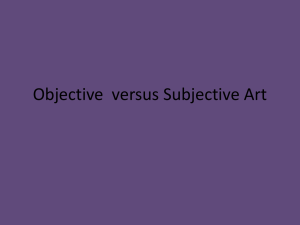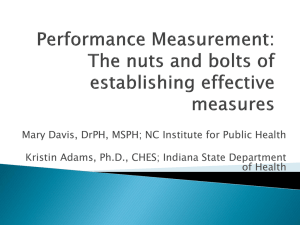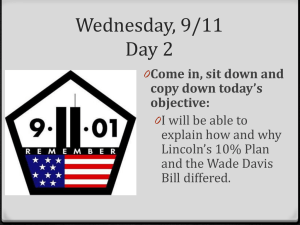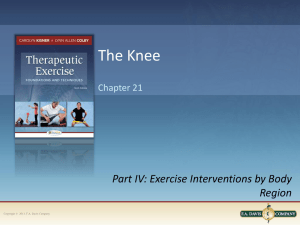Chapter 5 - PHT 1227 Therapeutic Exercise I
advertisement
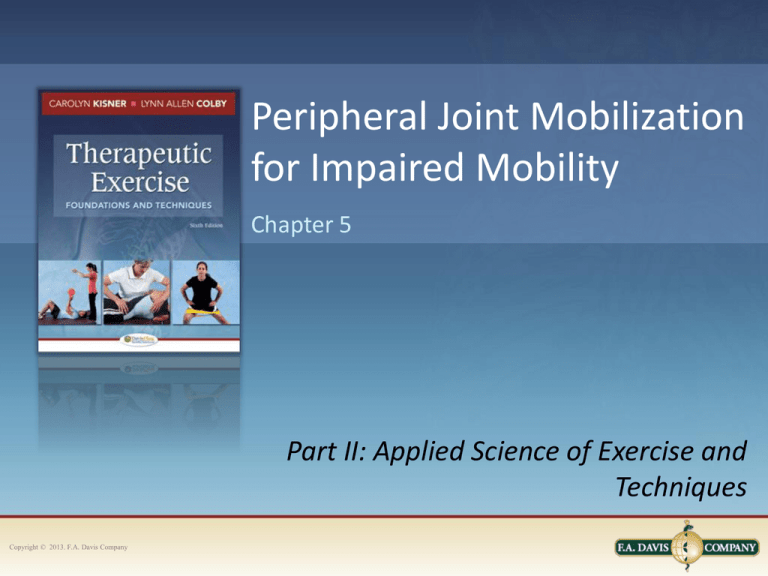
Peripheral Joint Mobilization for Impaired Mobility Chapter 5 Part II: Applied Science of Exercise and Techniques Copyright © 2013. F.A. Davis Company Joint Mobilization/Manipulation Manual therapy techniques that are used to modulate pain and treat joint impairments that limit ROM by specifically addressing the altered mechanics of the joint Copyright © 2013. F.A. Davis Company Definition of Terms Mobilization/Manipulation – Thrust manipulation/high-velocity thrust (HVT) Self-Mobilization (Auto-Mobilization) Mobilization With Movement (MWM) Physiological Movements – Osteokinematics Copyright © 2013. F.A. Davis Company Definition of Terms (cont'd) Accessory Movements – Component motion – Joint play: arthrokinematics Manipulation Under Anesthesia Muscle Energy Copyright © 2013. F.A. Davis Company Basic Concepts of Joint Motion: Arthrokinematics Joint Shapes – Ovoid – Sellar (saddle) Copyright © 2013. F.A. Davis Company Basic Concepts of Joint Motion: Arthrokinematics (cont'd) Types of Motion – Swing: Movement of the bony lever about an axis of motion – Motion of the bone surfaces in the joint • Roll • Slide/translation • Combined roll-sliding in a joint (glide) • Spin Copyright © 2013. F.A. Davis Company Convex-Concave Rule Basis for determining the direction of the mobilizing force when joint mobilization gliding techniques are used – Sliding is in the opposite direction of the angular movement of the bone if the moving surface is convex – Sliding is in the same direction if the moving surface is concave Copyright © 2013. F.A. Davis Company Passive-Angular Stretching Versus Joint-Glide Stretching Passive-angular stretching may cause increased pain or joint trauma Joint-glide is safer and more selective – Controlled – Replicates normal joint mechanics – Force is specific to target tissues Copyright © 2013. F.A. Davis Company Other Accessory Motions That Affect the Joint Compression Traction: Longitudinal Pull – Long axis traction Distraction: Separation of Joint Surfaces – Joint traction or joint separation Copyright © 2013. F.A. Davis Company Effects of Joint Motion Helps move synovial fluid to maintain cartilage health Maintains extensibility and tensile strength of articular and periarticular tissues Provides sensory input for proprioceptive feedback important for balance response Copyright © 2013. F.A. Davis Company Indications for Joint Mobilization/Manipulation Pain, Muscle Guarding, and Spasm – Neurophysiological effects – Mechanical effects Reversible Hypomobility Positional Faults/Subluxations Progressive Limitation Functional Immobility Copyright © 2013. F.A. Davis Company Limitations of Joint Mobilization/ Manipulation Techniques Cannot Change Disease Process Cannot Change Inflammatory Process Skill of the Therapist Affects the Outcome Copyright © 2013. F.A. Davis Company Contraindications Hypermobility Joint Effusion Inflammation Copyright © 2013. F.A. Davis Company Conditions Requiring Special Precautions for Stretching Malignancy Bone Disease Detectable on Radiograph Unhealed Fracture (With Limitations) Hypermobility in Associated Joints Total Joint Replacements Newly Formed or Weakened Connective Tissue Elderly Individuals Copyright © 2013. F.A. Davis Company Procedures for Applying Passive Joint Techniques Examination and Evaluation – Quality of pain – Capsular restriction (specific pattern) – Subluxation or dislocation Copyright © 2013. F.A. Davis Company Procedures for Applying Passive Joint Techniques (cont'd) Documentation – Use of standardized terminology – Characteristics of documentation • • • • • • Copyright © 2013. F.A. Davis Company Rate of application of movement Location of range in the available motion Direction of force applied by the therapist Target of force Relative structural movement Patient position Non-Thrust Oscillation Techniques Grade I: Small Amplitude at Beginning of Range – Pain inhibition and fluid movement Grade II: Large Amplitude Within the Range – Pain inhibition and fluid movement Grade III: Large Amplitude Up to the Limit into Resistance – Stretching maneuver Grade IV: Small Amplitude at the Limit into Resistance – Stretching maneuver Copyright © 2013. F.A. Davis Company Non-Thrust Sustained Joint-Play Techniques Grade I: Loosen: Small Amp Distraction – Pain relief Grade II: Tighten: Distraction or Glide to Tighten Tissue – Pain relief, assess joint sensitivity, maintain joint play Grade III: Stretch: Distraction or Glide – Increase joint play Copyright © 2013. F.A. Davis Company Comparison of Oscillation and Sustained Techniques Representation of Oscillation Techniques Copyright © 2013. F.A. Davis Company Representation of Sustained Joint-Play Techniques Thrust Manipulation/High-Velocity Thrust (HVT) Application – Small-amplitude, high-velocity – Performed only once Indications – Snap adhesions – Reposition joint surfaces Copyright © 2013. F.A. Davis Company Procedures for Applying Passive Joint Techniques Positioning and Stabilization Direction and Target of Treatment Force – Treatment plane Initiation and Progression of Treatment Patient Response Total Program Copyright © 2013. F.A. Davis Company Mobilization With Movement (MWM): Principles of Application Principles and Application of MWM in Clinical Practice – Comparable sign – Passive techniques – Accessory glide with active comparable sign – No pain – Repetitions – Description of techniques Copyright © 2013. F.A. Davis Company Mobilization With Movement (MWM): Principles of Application (cont'd) Patient Response and Progression – Pain as a guide – Self treatment – Total program Theoretical Framework – Brian Mulligan Copyright © 2013. F.A. Davis Company Peripheral Joint Mobilization Techniques Shoulder Girdle Complex Elbow and Forearm Complex Wrist and Hand Complex Hip Joint Knee Joint Complex Leg and Ankle Joints Copyright © 2013. F.A. Davis Company Independent Learning Activities Critical Thinking and Discussion Laboratory Practice Copyright © 2013. F.A. Davis Company

